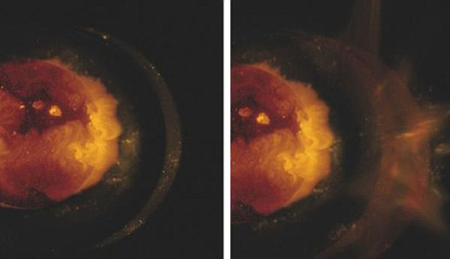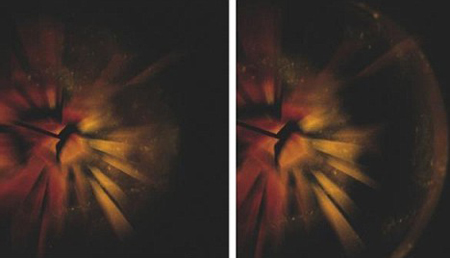The scientific world is confused because the
A star that is millions of times brighter than the sun explodes even under the age of immaturity enters the self-destruct phase. Its early death made many astronomers think that we have not understood the evolution of stars.

Superstar releases matter before collapsing into the mind by its own gravitational force.Photo: Weizmann Science Institute.
Hubble Space Telescope of the US Aerospace Agency (NASA) has discovered this supernova (the phenomenon of exploding the supernova). The explosion is 200 million light-years from Earth and occurred in 2005. Scientists at the Weizmann Institute of Science (Israel) and the University of San Diego (USA) claim that it is the largest supernova that astronomers witnessed.
According to modern theories about the evolution of the star, the bad superstar, has not reached the age of self-destruction. Until now, all supernovae exploded with a mass not exceeding 20 times the mass. But the star the Hubble telescope observes has 100 times the mass of the sun. That is what makes astronomers confused.
'That means that there is some reason why the other superstar destroys itself early, or we have a fundamental misunderstanding about the evolution of super-massive stars. If the second hypothesis is correct, current theories need to be reconsidered, 'said Avishay Gal-Yam, an expert at the Weizmann Institute of Science.

The death of stars that are 8 times bigger than the sun is spectacular.Photo: Weizmann Science Institute.
The timing of a star's self-destruction is determined from the moment it is formed by its size, as well as the energy source that helps it glow throughout life. Stars, including the sun, take energy from hydrogen nuclei mixed with helium in extremely hot temperatures and tremendous pressure inside the core. A helium nucleus is slightly lighter than the total mass of four hydrogen nuclei. According to Einstein's theory of relativity (E = mc 2 ), the lost mass is released into energy.
When sun-like stars burn off hydrogen fuel, they will emit material dust before they die in silence. But the process of self-destructing large stars (8 times the Sun and above) takes place quite complicated and loud. Nuclear fusion will continue after the hydrogen is depleted, creating heavier elements at different levels of the star. At some point, this process will turn the star's core into iron.
Under extreme pressure and temperature in the central region of the star, the iron nucleus decays into protons and neutrons. This phenomenon causes the core and the upper layers to collapse inside, pushing the star's remaining matter into space to create a super-large explosion in a short time. The energy that such an explosion unleashes for a few days by the energy that the sun releases during its lifetime. The brightness of the explosion was so great that, even if it happened 200 million light-years from Earth, we could still see it during the day.
After the explosion, the super-star's core reduced in size thousands of times, turning into black holes with 10-15 times the mass of the sun. Most of the star's matter is attracted to the black hole.
- Giant momentum makes the scientific world confused
- Parents are embarrassed by their scientific questions
- Movement of the scientific world in the past week
- China is about to lead the world in scientific research
- US special envoy to Vietnam
- Need to review the Nobel Prize?
- Top 10 scientific and technological achievements in 2011
- Why are rod beetles present throughout the planet?
- Will China usurp America in science?
- The biggest scientific breakthrough in 2010
- Extremely toxic scientific tricks with fluid that amaze you
- 5 'promise' inventions change the world
 Van Allen's belt and evidence that the Apollo 11 mission to the Moon was myth
Van Allen's belt and evidence that the Apollo 11 mission to the Moon was myth The levels of civilization in the universe (Kardashev scale)
The levels of civilization in the universe (Kardashev scale) Today Mars, the sun and the Earth are aligned
Today Mars, the sun and the Earth are aligned The Amazon owner announced a secret plan to build a space base for thousands of people
The Amazon owner announced a secret plan to build a space base for thousands of people